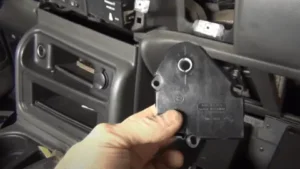If your air conditioning system is malfunctioning or blowing hot air at times, you may have already considered how to reset the AC on your Chevy Silverado.
Your vehicle’s climate control system is rather delicate; when one component fails, it affects the efficiency of the whole air conditioning system.
In this article, we discuss the different components of AC systems and the common issues they go through.
Simple and easy-to-follow guides to reset your AC system and HVAC actuator can also help you perform some DIY repairs on your beloved Chevy Silverado.
Common Silverado AC-related Problems and their Solutions
When your Chevy Silverado’s AC is not working, it is usually due to faulty or dirty components of the cooling system.
To diagnose the root of your car’s AC problem, we highly recommend you check the following car components and replace them when needed.
01. Faulty blend door actuators
The blend door actuators control the vents and airflow into your Chevy Silverado’s passenger area. Blend door actuators are also known as HVAC actuators.
If you hear rattling sounds against the dashboard, tap on your car door, or feel an inconsistent flow of air the first time you turn on the AC, the blend door actuators in your Chevy Silverado may have some problems.
Check on your HVAC actuators by removing them from their position underneath the dashboard. Carefully detach the actuator and replace it with a brand-new one.
02. Bad blower motor
If there is little to no airflow coming out of the vents, your Chevy Silverado’s blower motor may be broken. Since a broken blower motor cannot be fixed, your only choice is to replace it with a new one.
When your vehicle’s blower motor is busted, a whining and groaning sound comes from the passenger area where the blower motor is located.
Disconnect all HVAC wiring from the old blower under the dash. Remove the broken unit and install a new blower motor. Replacing a blower motor on a Chevy Silverado typically costs around $170.
03. Compressor failure
The compressor is the heart of the Chevy Silverado’s cooling system. To cool the inside of your vehicle, the compressor converts a coolant in a gaseous state into liquid.
When a compressor fails to function normally, it is already beyond repair. To get your vehicle’s cooling system up and running again, you will need to purchase a new compressor to replace the defective unit.
RELATED: Will The Heater Work Without AC Compressor In The Car
04. Refrigerant leak
Low refrigerant levels can cause cooling problems in your car. To fix this, check whether the refrigerant level is sufficiently stocked. Then, refill the refrigerant to get the cooling system up and running again.
However, if your Chevy Silverado runs out of refrigerant quickly, there may be a leak. This can be due to defects in components like a worn sealing ring or a busted condenser.
Solving refrigerant leaks may require swapping old car components for new ones.
05. Dirty evaporator
A dirty evaporator prevents the AC from producing cold air. Mold can develop on a diary evaporator, producing a moldy smell.
This indicates that the evaporator coil needs to be cleaned. Your Chevy Silverado’s evaporator should be maintained at least once a year.
06. Clogged condenser
The condenser exchanges heat from the refrigerant to the surrounding air outside the vehicle. Seated by the car grille, it is prone to dust, bugs, and other microparticles stuck between its mesh.
A clogged condenser struggles to release heat, leading to poor air ventilation inside the car.
Fixing a clogged condenser only requires a thorough cleaning unless the condenser is battered and worn. If you have access to a power washer, put it at the lowest setting and wash out the debris from the condenser’s fins.
07. Dirty cabin air filter
The cabin air filter keeps a healthy and clean air quality inside your Chevy Silverado. Due to the nature of their purpose, cabin air filters are prone to collecting grime, dust, and other microparticles that block their airways.
The air quality inside your vehicle is significantly reduced if you have a dirty and blocked air filter.
To fix cooling and air quality issues brought about by a dirty cabin filter, you must perform a thorough cleaning. With a vacuum cleaner or compressed air, clear the filter of dust and dirt that has collected around it.
If you are not satisfied with the results, you can opt to replace the cabin filter with a new unit.
Problems with the Chevy Silverado’s Climate Control System
As your Chevy Silverado ages or runs 100,000 miles, issues can manifest with the car’s climate control system.
The climate control system serves to ventilate drivers and passengers for a cool and comfortable riding experience in the Chevy Silverado.
However, no car component is made to last forever, regardless of the amount of care and maintenance. Common problems that arise with a malfunctioning climate control system are:
01. Defective control panel.
The control panel consists of the screen, knobs, buttons, etc, that allow you to adjust and customize the airflow and temperature inside your Chevy Silverado.
Defects can begin with the wear and tear of the hardware and the corrosion of electronics connecting the panel to the vehicle’s cooling system.
A defective control panel limits your capacity to adjust the temperature and airflow inside your car. To address this issue, replace the control panel with a brand new unit.
02. Failing sensors.
However, if your Chevy Silverado’s climate control panel shows no signs of defect or malfunction, the problem probably persists through at least a failing sensor.
The sensors in a climate control system regulate the strength of airflow and temperature inside the vehicle.
While older Chevy Silverado models would have at least two sensors, later models may have more sensors for more sophisticated temperature control.
If a sensor is defective, the data output sent to the climate control system will be insufficient to provide the actual airflow and temperature settings that are most suitable for the car’s surroundings.
Your vehicle’s temperature sensors will notify you with a warning if they are malfunctioning and due for a replacement.
03. Malfunctioning HVAC actuators.
Malfunctioning HVAC actuators or blend motors can complicate diagnosing the root of your Chevy Silverado’s climate control system problem.
The HVAC actuator is linked to most components of the car’s cooling system.
You will notice the HVAC actuator acting up when unusual whirring sounds come from behind the glove box.
A defective HVAC actuator can affect other components such as the blower motor in regulating airflow through the AC vents. You will also feel that hot air is blowing in one half of the car, while the other half is cool.
This difference in cooling is a common issue among car models installed with a dual-zone climate control system, such as the Chevy Silverado.
You can replace your vehicle’s HVAC actuator or have an auto mechanic take a look. However, replacing the blend motor does not guarantee that your climate control system will be back to 100% functionality.
A malfunctioning blend motor may have been caused by other car cooling components that also need maintenance.
A Step-by-Step Guide for How to Reset AC on Chevy Silverado
Guide to Reset Your Chevy Silverado Climate Control System
Various errors in software, electronic wiring, or hardware defects in the Chevy Silverado climate control system can be corrected through a reset. Below is a step-by-step guide to helping you reset your Chevy Silverado’s AC controls:
- Turn your car’s ignition off. Locate the HVAC fuse under the hood.
- Unplug the HVAC fuse. Wait for 10 seconds.
- Plug it back in again and wait for about a minute. Your car’s climate control system will automatically restart at this point.
- After waiting for a minute or two, your car is done resetting your AC. Turn the engine on and test whether the cooling system is functioning normally.
- Press down on the minimum and maximum buttons on your climate control panel. This will trigger the Automatic Stability Control light.
- With the ASC lit, release your hold on the two buttons. This prompts your vehicle to reset its climate control system.
Repeat the entire procedure two to three times until all the air vents in your car are blowing cold air. This reset will address issues persisting due to select cars’ dual climate zone controls.
Restarting the AC reprogrammes actuators and sensors to work based on new setting entries and data.
The Chevy Silverado is built with a dual climate zone control system.
Owners of this car model will recognize the dual climate zone control acting up when one side of the car receives hot air from the vents while the other side is cool, despite both sides being programmed to blow cold air.
To this day, Chevrolet has yet to officially address this issue and release a solution for future generations of the Silverado model. As car owners, we seek ways and techniques to circumvent this issue.
However, multiple restarts are sometimes not enough for other vehicles. We suggest asking a mechanic for expert advice to fix the AC problem.
How to Reset Your Chevy Silverado Blend Door Actuator?

The blend door actuator regulates airflow and temperature in your Chevy Silverado. It comprises your car’s dual-zone climate control system’s complex HVAC (heating, ventilation, and air conditioning) system.
You may have to reset your blend door actuator when it is not responding to the programmed controls as it should be. To perform a blend door actuator reset on your Chevy Silverado, follow our step-by-step guide provided below:
- Disassemble the lower dash panel. The blend door motor is typically placed in the glove box.
- Unscrew the motor from its mount. Take caution not to yank the blend door motor out because there may still be hidden screws installed.
- After taking out all the screws, slowly pull the blend door motor out. Disconnect all the wirings carefully. The wires tend to be fragile, so avoid abruptly tugging them off.
- Assess the air door pivot. Check whether it turns in all directions smoothly. Look out for obstructions that may hinder the door pivot from functioning properly.
- With the door pivot set, return to the blend door motor. Dislodge the actuator and replace it with a brand-new actuator.
- With the blend door actuator intact again, it’s time to test out the wirings. Reconnect the wires and see if the newly replaced blend door actuator is responding. If not, recheck the placement of the door pivot and actuator.
- You are all set to put back the actuator in its mount. Securely screw the unit back to its original position. You will hear a clicking sound when the actuator is snugly in place.
- Reassemble your lower dash panel. After returning everything to its original position, wait around two minutes before turning the ignition on and assessing your car’s cooling system.
FAQs about How to Reset AC on Chevy Silverado
01. Why is the AC in my Chevy Silverado only blowing hot air?
Your AC system may have malfunctioning components. Check if you have enough refrigerant or if your compressor is dried or eroding.
02. Where can I find the blend door actuator in my Silverado?
The blend door actuator is placed behind the dashboard on the passenger’s side. It typically sits behind the car’s climate control system.
03. Why is my AC system not functioning after changing the car battery?
Check whether any connection was suddenly unplugged upon changing the battery. Otherwise, your car’s cooling system is depressurized, preventing cold air from flowing through the air vents.
04. Where can I find the AC fuse in my 2014 Silverado?
The AC fuse is situated on the side of the dashboard at the passenger’s seat. Checking on your fuses is important to maintain the proper functioning of your car’s different components.
05. What is dual-zone climate control?
Newer Chevy Silverado and other car models are equipped with a dual-zone climate control system. This system allows passengers on the rear side of the car to control and adjust the temperature in their area through a control panel separate from that installed at the front.
Verdict
The Chevy Silverado AC System is not free of errors and hardware defects. Rather, the dual-zone climate control system installed in the Silverado models causes significant cooling system problems.
The lack of initiative from Chevrolet in addressing the climate control issues is upsetting.
Thus. Owners must be creative or willing to stop by the mechanic frequently to inspect and have various AC components cleaned and replaced. A functional AC system is important for a comfortable and hassle-free drive.

Bruce William is a professional content writer and vehicle engineer with extensive car maintenance and repair knowledge. His expertise spans all vehicle parts, offering practical solutions for various automotive issues. Bruce provides valuable insights through his website articles to help readers maintain their cars for optimal performance and longevity.
